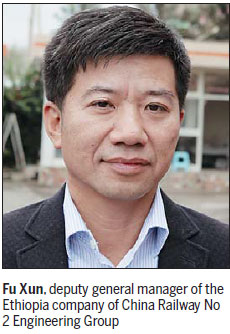
Two Chinese companies are building what many consider the biggest construction project in Ethiopia's history
When China was still considered a poor country in the 1960s and '70s, its workers left in their tens of thousands for Tanzania and Zambia to survey, build, then manage Africa's first cross-border railway, the 1,860-km Tazara, which linked the port of Dar es Salaam in Tanzania, with the town of Kapiri Mposhi, in Zambia's Central province.
Many lives were lost, such were the harsh working conditions for those early Chinese railway pioneers.

|
Top: Youngsters lap up the scenery near the foundations of the cross-border railway. Above: Workers with the Ethiopia company of China Railway No 2 Engineering Group prepare to lay tracks of the cross-border railway. Photos by Fu Jing / China Daily |
Fast forward to the present day, and again Chinese muscle power and know-how is being used on another flagship rail link, this time connecting land-locked Ethiopia's capital, Addis Ababa, and Djibouti, the strategic port city to its east, on the Horn of Africa.
Costing $4 billion, the 740-km line will be the first overseas electric railway built to Chinese standards.
When it is completed by the end of next year, passengers will be carried at 120 km/h between the cities; and as they did on the building of the Tazara decades ago, thousands of Chinese workers have arrived to build it, many of whom are the sons of those earlier railway migrants.
The new line's foundations are now almost finished, but not without some careful blasting of numerous tunnels, and the building of many bridges. The next stage is to lay the tracks.
It is an exaggeration to say mountains have been moved to reach this stage - but according to project managers it is not far from the truth at some stages of the work.
For months, home for many of the workers has been huge portable accommodation units.

The project is being jointly handled by China Railway No 2 Engineering Group, which is building the first 329 km from Addis Ababa, and China Civil Engineering Construction Corporation, which is completing the rest of the work to Djibouti.
Fu Xun is deputy general manager of China No 2's project team, an industry veteran who has been building railways in China since graduating in the early 1980s.
He has been in Ethiopia since the project started in 2011, and says between 7,000 and 10,000 jobs have been created locally in that time.
"Compared with the efforts of the older generation in Tanzania and Zambia, our conditions are a lot better, certainly, but we still face a lot of challenges," Fu says, in the relative air-conditioned comfort of his office near Adama, Ethiopia's second-biggest city.
"But our difficulties are nothing compared with the benefits Ethiopians are going to enjoy as a result of the project."
He is not just talking about the travel comfort, but also the expected boost to communities along the route of the new railway.
Over the past 30 years, Chinese towns and cities that have found themselves along the routes of new railway lines have prospered, and attracted huge investment in the shape of industrial parks and real estate.
Ten stations are planned along the section Fu's company is building, each of which is expected to become an economic center in its own right, he says, under the country's five-year growth and transformation plan.
"We hope that scenario can be turned into reality as soon as possible.

"Once the railway is put into operation, it will change the economic geography of Ethiopia."
Until now, Ethiopia's growing exports have had to rely on being transported via badly maintained roads, especially the one from Addis to the port of Djibouti, which in effect represents its only lifeline for goods in and out of the country.
It now takes at least 20 days to carry goods between the two cities, compared with an expected journey time of seven to eight hours using the new train line.
"This will allow huge savings on logistics costs, and it will increase Ethiopia's appeal as an investment destination," adds Fu, who knows full well the current transport limitations, given much of the equipment being used on the railway's construction has had to come from China, into Djibouti, then on by road.
The building of the 10 stations is expected to create at least 5,000 jobs, but of course it is also realistic to expect many may be lost as road transport companies feel the competition in future.
Habtamu Asefa, 24, is the foreman of a group of Ethiopians building sleepers for the railway, in a temporary factory near Adama.
Born and bred in the area, he has been working on the project for a year and says he is excited by the changes the railway will bring.
Ethiopian per capita GDP is $500, but Asefa says his workers can earn about $100 a month. His monthly wage is as high as $160.
"We are clearly happy that the construction has brought such a lot of work for me and my people," he says.
Fu calculates that about 600,000 sleepers have been used, and another 900,000 will be needed for the main line and the lines into the stations.

Fu says his company has invested heavily in training the new workforce, on what many are describing as the biggest project in Ethiopia's history.
All the engineering plans have been produced in Chinese, English and Amharic, a Semitic language spoken in Ethiopia, to ensure every worker can understand them.
Work teams consist of 10 locals, led by an Ethiopian deputy team leader who can speak English, and a Chinese team leader.
China No 2 has employed more than 20 local sub-contractors, some of whom, again, have had to be given training on Chinese railway engineering techniques.
One striking difference between this new generation of Chinese railways workers and their predecessors, Fu says, is their ability to communicate easily and regularly with their families in China.
Regular home cooking and Chinese TV programs on the construction sites have also helped to ease the strain of being away for months on end.
"Our workers have also begun to adapt themselves to local lifestyles and cultures," Fu says, with many starting to learn Amharic.
Using Chinese-made tracks, trains and signaling systems is a great international advertisement for the country's expertise, and the made-in-China brand, he says.
"The African Union is based in Addis Ababa, so this project is a perfect opportunity for us to showcase the competitiveness of China's railway capacities," Fu says, with obvious pride.
"As a result, we hope our technology will be widely used in other African countries too."
fujing@chinadaily.com.cn
(China Daily Africa Weekly 10/03/2014 page19)
